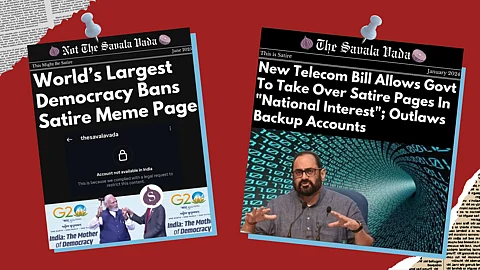
- HOMEGROWN WORLD
- #HGCREATORS
- #HGEXPLORE
- #HGVOICES
- #HGSHOP
- CAREERS
- ABOUT US
- CONTACT US

Over the weekend, The Savala Vada — a satirical homegrown meme account with over 85,000 followers — was geo-blocked on Instagram in India. No specific violation was cited. A notification from Meta stated the account, “may not be viewable to some users,” which, on closer inspection, turned out to mean only one country: India.
The absurdity writes itself. A meme page, operated by a group of twentysomethings out of college dorms and shared Google Docs, is apparently threatening enough to the Indian state to warrant digital exile. But then again, it’s not so absurd. In a digital environment where the tone and reach of public conversation are increasingly mediated, accounts like The Savala Vada have become rather unexpected key players. They joke, yes — but they also document, contextualise, and reflect. In doing so, they offer something traditional media can’t: immediacy, cultural fluency, and a distinct point of view.
“We’re not journalists,” The Savala Vada's (SV) anonymous creator is quick to clarify. “We don’t go out in the field. We don’t report. But what we do is take that reporting and reframe it, make it legible to people who would otherwise scroll past.”
That tension — between not being a newsroom and still helping people understand the world — is central to The Savala Vada. The account mimics the design of a newspaper: bold headlines, punchy visuals, rigid typographic hierarchies. But what fills those frames is anything but typical. “14th Hungriest Country Unveils Nuclear Submarine” isn’t a headline you’ll find in print, but it distills a sentiment that feels grounded in lived reality.
“In this new age,” SV says, “news itself is a meme. But most of it is just boring.” He means this literally. The original meaning of a 'meme' — coined by Richard Dawkins as a unit of cultural transmission — has been stripped to its bones thanks to a combination of reaction gifs, TikToks, and Whatsapp forward. The Savala Vada represents a return to that older, more classical definition: a tool of compressed clarity. “The whole idea,” they explain, “is to take something overwhelming — say, Kashmir, or caste, or corporate media — and distill it down into something that fits in one frame. Something that hits harder than a headline.”
The team behind The Savala Vada has long known they were operating in a grey area between humour and hostility. Their satire is often misread — sometimes gleefully, sometimes wilfully. One meme referring to a fictional war victory by “Hindurashtra” was shared unironically by Hindu nationalist accounts. “We joke about Bharat leading Hindurashtra to victory,” SV recalls, “and people are like yes! Victory! It’s our empire!”
And yet, that ambiguity is the point. Satire, by definition, allows room for misinterpretation. But it’s also one of the few tools left for skirting censorship. “Humour is one of the last safe spaces,” SV says. “But even that’s shrinking.” The irony is that humour is safest precisely because it appears unserious.
"We’re clowns, right? We’re the jester in the emperor’s court. That has been a historic role — the emperor has always allowed the jester to poke fun and mock his power. He never kills the jester either. He kills his political opponents, but the jester is harmless. Now, even that’s under threat."
The Savala Vada to Homegrown
Like many politically conscious young Indians, SV didn’t start out trying to “do politics.” The Savala Vada began "out of disillusionment" with legacy newsrooms. “Mainstream media isn’t evil,” they insist. “It’s just broke, scared, and dependent on ad revenue from the state.”
Faced with that collapse, satire became a form of survival. Accounts like The Savala Vada have found themselves at the heart of political discourse: humour simplifies complexity, cuts through noise, and builds solidarity. Memes are most powerful because they transcend traditional political communication by bypassing both gatekeepers and decorum.
Meme pages have come to occupy a space that’s hard to pin down. They're part joke, part newswire, and part resistance archive. Thinking of memes as nonsense is a kind of literary prejudice. What they actually offer is a new grammar of cultural production: fast, participatory, emotionally charged, and endlessly mutable.
The Savala Vada speaks in the voice of the internet — frustrated, funny, tired, sharp. “Our job is to take what's happening and make it legible,” SV says. “To turn ‘Karachi Port seized’ into something people will actually read.”
And that, SV insists, is political. Not in the capital-P sense of party lines, but in the way a meme about Chhota Bheem can sit next to one about caste. “That’s the thing about meme culture,” they say. “You meet people where they are. Someone who watches Bigg Boss now knows about Palestine.”
This is the power of memes: their ability to simultaneously mock, inform, and build identity. In The Savala Vada’s case, that identity is specifically Indian, specifically digital, and deeply aware of the hypocrisies it’s swimming in. “We’re just a meme page,” SV laughs. “But we’re also charting history in real time. We’re documenting things that no one else will.”
If meme pages have become a threat, it’s not because they command mass power, but because they command mass attention. In a nation where the borders of acceptable speech grow tighter by the day, even a punchline is punished. Yet, SV isn’t angry. He returns, at the end of our conversation, to a metaphor that has stayed with me since.
“We’re clowns, right? We’re the jester in the emperor’s court. That has been a historic role — the emperor has always allowed the jester to poke fun and mock his power. He never kills the jester either. He kills his political opponents, but the jester is harmless. Now, even that’s under threat."
The Savala Vada was blocked for being too funny. And in this new India, that might just be the most subversive thing you can be.
